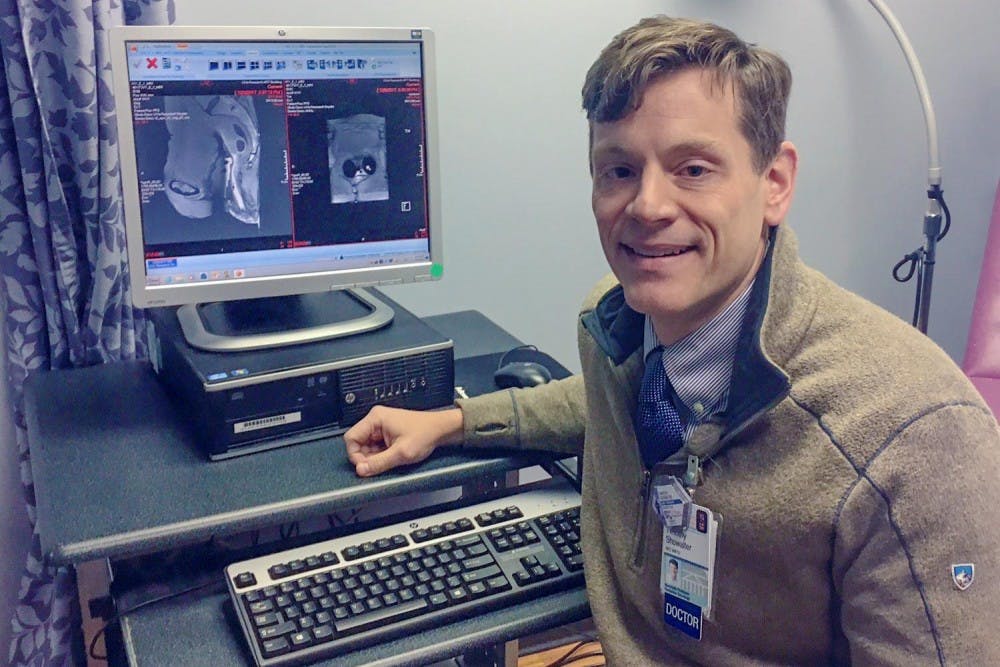A study led by the University Hospital radiation oncologist Dr. Timothy Showalter indicates that brachytherapy — a type of radiation treatment where the radioactive sources are placed directly inside the body — is underutilized for the treatment of cervical cancer despite being a critical aspect of treatment. External beam radiation, while often used in combination with brachytherapy, is less effective when used alone in the treatment of cervical cancer.
According to Showalter, cervical cancer is different from other cancers because it is the only cancer where brachytherapy is a critical component of a non-surgical treatment approach.
Dr. Shiv Khandelwal, who also works in radiation oncology at the University, says placement of the radiation sources directly inside the body as done in brachytherapy provides an effective high dosage to the cancerous tissue.
“When you’re giving external radiation, you’re having to treat through a number of organs to get to the cervix,” Khandelwal said. “With brachytherapy what you’re doing is treating from the inside out — radioactive sources are placed inside the cervix — and because of inverse square law, the radiation dose is very, very high close to the radioactive sources but then drops off rapidly away from the sources.”
According to Assoc. Radiation Oncology Prof. Bruce Libby, lack of resources and improper incentives have contributed to the decreasing use of brachytherapy. For instance, brachytherapy involves the presences of both a licensed physician and physicist — which some facilities do not have access to. Additional personnel can also increase the cost of conducting the treatment.
In the study, Showalter was able to calculate the cost of delivery for the different types of radiation therapy for cervical cancer. Medical student Kristine Bauer-Nilsen, who assisted with the study, said the discrepancy in the cost and reimbursement of brachytherapy treatment was striking.
“We found that about 50 percent of the total cost for cervical cancer treatment was personnel cost,” Bauer-Nilsen said in an email to The Cavalier Daily. “Brachytherapy consumed about 80 percent of total physician time and was associated with a smaller proportion of total reimbursements per course compared to external beam radiation therapy.”
According to Bauer-Nilsen, a relative value unit (RVU) is used by hospitals as a measure of productivity and is associated with physician reimbursement. The study showed that the amount of time spent by an attending physician was four times higher per RVU for brachytherapy compared to external beam radiation therapy. Therefore, it is cheaper for physicians to only perform external beam radiation therapy as their rate of radiation will be higher.
“It’s not a really a very level playing field,” Khandelwal said. “External beam radiation doesn’t require nearly as much effort as brachytherapy, but brachytherapy is not really reimbursed at a rate that makes up for the difference in labor costs and effort.”
While the decrease in brachytherapy has been observed nationwide, brachytherapy is typically more common in metropolitan and high-volume regions as compared to smaller, rural places. Showalter said that smaller community practices may be limited by financial constraints and only be able to offer external beam radiation. While the physicians may urge patients to travel to other facilities for brachytherapy, patients may be unable to do so due to their jobs. Therefore, patients may be forced to receive only external beam radiation therapy which has been proven to have a lower curative rate compared to a combined treatment plan involving both external radiation and brachytherapy.
Although cervical cancer requires a combined treatment using both brachytherapy and external beam radiation therapy, not all cancers are treated in the same manner. According to Showalter, the use of brachytherapy in prostate cancer has also decreased. However, there is not a clear difference in survival outcomes for the patients, and so it is more economical to use external beam radiation therapy.
Libby said this study was beneficial because it was able to quantify the problem and discrepancy in reimbursement for brachytherapy.
“We know personally that yes, these treatments take more physician time and physicist time and more resources from the clinic and hospital, but now we’ve quantified it,” Libby said. “So now that we’ve quantified it, we can then say these are the numbers, this is the issue. Now we can go and say how are we going to solve this problem.”
Bauer-Nilsen said the ultimate goal is to cause a change in current reimbursement practices so that cost-effective care can be delivered to patients. The results from this study should be able to inform policymakers as to the need for an increase in reimbursement for brachytherapy.
Showalter also said that patient transportation should be facilitated so that they are able to receive adequate healthcare. In fact, Showalter is a part of a telemedicine project which would allow physicians at the University to give consultations to patients in more rural regions as well as help local doctors deliver more specialized care.
Brachytherapy is not the only underutilized treatment despite its efficiency. Khandelwal treats many skin cancer cases which sometimes require a non-surgical approach as to avoid complications with plastic surgical reconstruction due to the location of the cancerous tissue.
These types of skin cancer can be treated through radiation by either doing external beam radiation or superficial X-ray therapy. External beam radiation requires the use of a linear accelerator which costs between two to four million dollars while superficial X-ray therapy requires a machine which costs $150,000. Furthermore, superficial X-ray therapy is more beneficial to the patients compared to the electrons delivered through the linear accelerator.
However, many facilities do not have the additional equipment necessary for superficial X-ray therapy and have no incentive to maintain a second piece of equipment from the insurance companies.
“We have to remember this is about what’s doing best for the patient,” Libby said.







